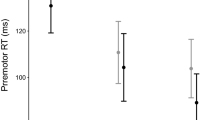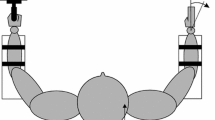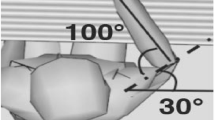Abstract
Perturbations delivered to the upper limbs elicit reflexive responses in stretched muscle at short- (M1: 25–50 ms) and long- (M2: 50–100 ms) latencies. When presented in a simple reaction time (RT) task, the perturbation can also elicit a preprogrammed voluntary response at a latency (< 100 ms) that overlaps the M2 response. This early appearance of the voluntary response following a proprioceptive stimulus causing muscle stretch is called a triggered reaction. Recent work has demonstrated that a perturbation also elicits activity in sternocleidomastoid (SCM) over a time-course consistent with the startle response and it was, therefore, proposed that the StartReact effect underlies triggered reactions (Ravichandran et al., Exp Brain Res 230:59–69, 2013). The present work investigated whether perturbation-evoked SCM activity results from startle or postural control and whether triggered reactions can also occur in the absence of startle. In Experiment 1, participants “compensated” against a wrist extension perturbation. A prepulse inhibition (PPI) stimulus (known to attenuate startle) was randomly presented before the perturbation. Rather than attenuating SCM activity, the responses in SCM were advanced by the PPI stimulus. In Experiment 2, participants “assisted” a wrist extension perturbation. The perturbation did not reliably elicit startle but despite this, two-thirds of trials had RTs of less than 100 ms and the earliest responses began at ~ 70 ms. These findings suggest that SCM activity following a perturbation is the result of postural control and is not related to startle. Moreover, an overt startle response is not a prerequisite for the elicitation of a triggered reaction.





Similar content being viewed by others
Notes
It is possible that our conservative startle classification criteria (bilateral OOc and bilateral SCM within 120 ms of a stimulus) contributed to the low incidence of startle (18.1%) on SAS-Catch trials. We further examined SAS-Catch condition, particularly the trials that showed bilateral SCM activity but no responses in OOc.It was rare to observe SCM activity in the absence of OOc (7 out of 237 SAS-Catch trials). Of these trials, the response only appeared in ECR on four trials (mean onset of 111 ms; i.e., not StartReact-like latency). Three other trials were classified as having bilateral SCM and unilateral OOc activity. The preprogrammed ECR response appeared on all three trials with a mean onset of 118 ms. The majority of SAS-Catch trials had bilateral OOc activity but no activity in SCM at < 120 ms. Thus, the conservative classification of what constitutes a startle response used in this study [which was implemented to protect against a high proportion of false-positive startle responses (due to postural SCM) on mechanical perturbation trials; see Methods], was unlikely to produce a high proportion of false-negative startle responses.
References
Abbs JH, Gracco VL, Cole KJ (1984) Control of multimovement coordination: Sensorimotor mechansims in Speech motor programming. J Mot Behav 16:195–232
Alibiglou L, MacKinnon CD (2012) The early release of planned movement by acoustic startle can be delayed by transcranial magnetic stimulation over the motor cortex. J Physiol 590:919–936
Álvarez-Blanco S, Leon L, Valls-Solé J (2009) The startle reaction to somatosensory inputs: different response pattern to stimuli of upper and lower limbs. Exp Brain Res 195:285–292
Brown P, Rothwell JC, Thompson PD, Britton TC, Day BL, Marsden CD (1991) New observations on the normal auditory startle reflex in man. Brain 114:1891–1902
Campbell AD, Squair JW, Chua R, Inglis JT, Carpenter MG (2013) First trial and StartReact effects induced by balance perturbations to upright stance. J Neurophysiol 110:2236–2245
Carlsen AN, Chua R, Inglis JT, Sanderson DJ, Franks IM (2004a) Can prepared responses be stored subcortically? Exp Brain Res 159:301–309
Carlsen AN, Chua R, Inglis JT, Sanderson DJ, Franks IM (2004b) Prepared movements are elicited early by startle. J Mot Behav 36:253–264
Carlsen AN, Dakin CJ, Chua R, Franks IM (2007) Startle produces early response latencies that are distinct from stimulus intensity effects. Exp Brain Res 176:199–205
Carlsen AN, Chua R, Inglis JT, Sanderson DJ, Franks IM (2009) Differential effects of startle on reaction time for finger and arm movements. J Neurophysiol 101:306–314
Carlsen AN, Maslovat D, Lam MY, Chua R, Franks IM (2011) Considerations for the use of a startling acoustic stimulus in studies of motor preparation in humans. Neurosci Biobehav Rev 35:366–376
Carlsen AN, Maslovat D, Franks IM (2012) Preparation for voluntary movement in healthy and clinical populations: evidence from startle. Clin Neurophysiol 123:21–33
Castellote JM, Kofler M, Mayr A, Saltuari L (2017) Evidence for startle effects due to externally induced lower limb movements: implications in neurorehabilitation. BioMed Res Int
Crago PE, Houk JC, Hasan Z (1976) Regulatory actions of human stretch reflex. J Neurophysiol 39:925–935
Dean LR, Baker SN (2017) Fractionation of muscle activity in rapid responses to startling cues. J Neurophysiol 117:1713–1719
Delval A, Dujardin K, Tard C et al (2012) Anticipatory postural adjustments during step initiation: elicitation by auditory stimulation of differing intensities. Neurosci 219:166–174
Evarts EV, Granit R (1976) Relations of reflexes and intended movements. In: Homma S (ed) Understanding the stretch reflex. Elsevier, Amsterdam, pp 1–14
Evarts EV, Tanji J (1976) Reflex and intended responses in motor cortex pyramidal tract neurons of monkey. J Neurophysiol 39:1069–1080
Evarts EV, Vaughn WJ (1978) Intended arm movements in response to externally produced arm displacements in man. In: Desmedt JE (ed) Cerebral motor control in man: long-loop mechanisms. Karger, Basel, pp 178–192
Forgaard CJ, Franks IM, Maslovat D, Chin L, Chua R (2015) Voluntary reaction time and long-latency reflex modulation. J Neurophysiol 114:3386–3399
Forgaard CJ, Franks IM, Maslovat D, Gowan NJ, Kim JC, Chua R (2016) An examination of the startle response during upper limb stretch perturbations. Neurosci 337:163–176
Glencross DJ, Koreman MM (1979) The processing of proprioceptive signals. Neuropsychologia 17:683–687
Hammond PH (1956) The influence of prior instruction to the subject on an apparently involuntary neuro-muscular response. J Physiol 132:17–18P
Herter TM, Takei T, Munoz DP, Scott SH (2015) Neurons in red nucleus and primary motor cortex exhibit similar responses to mechanical perturbations applied to the upper-limb during posture. Front Integr Neurosci 9
Houk JC (1978) Participation of reflex mechanisms and reaction-time processes in the compensatory adjustments to mechanical disturbances. In: Desmedt JE (ed) Cerebral motor control in man: long-loop mechanisms. Karger, Basel, pp 193–213
Jaeger RJ, Gottlieb GL, Agarwal GC (1982) Myoelectric responses at flexors and extensors of human wrist to step torque perturbations. J Neurophysiol 48:388–402
Johansson RS, Westling G (1988) Programmed and triggered actions to rapid load changes during precision grip. Exp Brain Res 71:72–86
Katz R, Rondot P (1978) Muscle reaction to passive shortening in normal man. Electroencephalogr Clin Neurophysiol 45:90–99
Koshland GF, Hasan Z (2000) Electromyographic responses to a mechanical perturbation applied during impending arm movements in different directions: one-joint and two-joint conditions. Exp Brain Res 132:485–499
Landis C, Hunt W (1939) The startle pattern. Farrar & Rinehard, New York
Lee RG, Tatton WG (1975) Motor responses to sudden limb displacements in primates with specific CNS lesions and in human patients with motor system disorders. Can J Neurol Sci 2:285–293
Lewis GN, MacKinnon CD, Perreault EJ (2006) The effect of task instruction on the excitability of spinal and supraspinal reflex pathways projecting to the biceps muscle. Exp Brain Res 174:413–425
MacKinnon CD, Verrier MC, Tatton WG (2000) Motor cortical potentials precede long-latency EMG activity evoked by imposed displacements of the human wrist. Exp Brain Res 131:477–490
Manning CD, Tolhurst SA, Bawa P (2012) Proprioceptive reaction times and long-latency reflexes in humans. Exp Brain Res 221:155–166
Maslovat D, Kennedy PM, Forgaard CJ, Chua R, Franks IM (2012) The effects of prepulse inhibition timing on the startle reflex and reaction time. Neurosci Lett 513:243–247
Maslovat D, Franks IM, Leguerrier A, Carlsen AN (2015) Responses to startling acoustic stimuli indicate that movement-related activation is constant prior to action: a replication with an alternate interpretation. Physiol Rep 3:e12300
Miscio G, Pisano F, Del Conte C, Pianca D, Colombo R, Schieppati M (2001) The shortening reaction of forearm muscles: the influence of central set. Clin Neurophysiol 112:884–894
Nashner LM, Cordo PJ (1981) Relation of automatic postural responses and reaction-time voluntary movements of human leg muscles. Exp Brain Res 43:395–405
Nonnekes J, Oude-Nijhuis LB, de Niet M et al (2014) StartReact restores reaction time in HSP: evidence for subcortical release of a motor program. J Neurosci 34:275–281
Nonnekes J, Carpenter MG, Inglis JT, Duysens J, Weerdesteyn V (2015) What startles tell us about control of posture and gait. Neurosci Biobehav Rev 53:131–138
Omrani M, Murnaghan CD, Pruszynski JA, Scott SH (2016) Distributed task-specific processing of somatosensory feedback for voluntary motor control. eLife 5:e13141
Oude-Nijhuis LB, Allum JHJ, Valls-Solé J, Overeem S, Bloem BR (2010) First trial postural reactions to unexpected balance disturbances: a comparison with the acoustic startle reaction. J Neurophysiol 104:2704–2712
Prochazka A, Clarac F, Loeb GE, Rothwell JC, Wolpaw JR (2000) What do reflex and voluntary mean? Modern views on an ancient debate. Exp Brain Res 130:417–432
Pruszynski JA, Scott SH (2012) Optimal feedback control and the long-latency stretch response. Exp Brain Res 218:341–359
Pruszynski JA, Kurtzer I, Scott SH (2008) Rapid motor responses are appropriately tuned to the metrics of a visuospatial task. J Neurophysiol 100:224–238
Pruszynski JA, Kurtzer I, Lillicrap TP, Scott SH (2009) Temporal evolution of “automatic gain-scaling”. J Neurophysiol 102:992–1003
Pruszynski JA, Kurtzer I, Scott SH (2011) The long-latency reflex is composed of at least two functionally independent processes. J Neurophysiol 106:449–459
Pruszynski JA, Omrani M, Scott SH (2014) Goal-dependent modulation of fast feedback responses in primary motor cortex. J Neurosci 34:4608–4617
Ravichandran VJ, Honeycutt CF, Shemmell J, Perreault EJ (2013) Instruction-dependent modulation of the long-latency stretch reflex is associated with indicators of startle. Exp Brain Res 230:59–69
Rothwell JC (2006) The startle reflex, voluntary movement, and the reticulospinal tract. Suppl Clin Neurophysiol 58:223–231
Rothwell JC, Traub MM, Marsden CD (1980) Influence of voluntary intent on the human long-latency stretch reflex. Nature 286:496–498
Scott SH (2004) Optimal feedback control and the neural basis of volitional motor control. Nat Rev Neurosci 5:532–546
Shemmell J (2015) Interactions between stretch and startle reflexes produce task-appropriate rapid postural reactions. Front Integr Neurosci 9
Shemmell J, An JH, Perreault EJ (2009) The differential role of motor cortex in stretch reflex modulation induced by changes in environmental mechanics and verbal instruction. J Neurosci 29:13255–13263
Shemmell J, Krutky MA, Perreault EJ (2010) Stretch sensitive reflexes as an adaptive mechanism for maintaining limb stability. Clin Neurophysiol 121:1680–1689
Stapley PJ, Drew T (2009) The pontomedullary reticular formation contributes to the compensatory postural responses observed following removal of the support surface in the standing cat. J Neurophysiol 101:1334–1350
Stevenson AJT, Chiu C, Maslovat D, Chua R, Gick B, Blouin J-S, Franks IM (2014) Cortical involvement in the StartReact effect. Neurosci 269:21–34
Strick PL (1983) The influence of motor preparation on the response of cerebellar neurons to limb displacements. J Neurosci 3:2007–2020
Valls Solé J, Rothwell JC, Goulart F, Cossu G, Munoz E (1999) Patterned ballistic movements triggered by a startle in healthy humans. J Physiol 516:931–938
Valls-Solé J, Kofler M, Kumru H, Castellote JM, Sanegre MT (2005) Startle-induced reaction time shortening is not modified by prepulse inhibition. Exp Brain Res 165:541–548
Valls-Solé J, Kumru H, Kofler M (2008) Interaction between startle and voluntary reactions in humans. Exp Brain Res 187:497–507
Weiler J, Saravanamuttu J, Gribble PL, Pruszynski JA (2016) Coordinating long-latency stretch responses across the shoulder, elbow and wrist during goal-directed reaching. J Neurophysiol 116:2236–2249
Yeomans JS, Li L, Scott BW, Frankland PW (2002) Tactile, acoustic and vestibular systems sum to elicit the startle reflex. Neurosci Biobehavi Rev 26:1–11
Yeomans JS, Lee J, Yeomans MH, Steidl S, Li L (2006) Midbrain pathways for prepulse inhibition and startle activation in rat. Neurosci 142:921–929
Acknowledgements
This work was supported by the National Sciences and Engineering Research Council of Canada.
Author information
Authors and Affiliations
Corresponding author
Ethics declarations
Ethical approval
All procedures performed in studies involving human participants were in accordance with the ethical standards of the institutional and/or national research committee and with the 1964 Helsinki declaration and its later amendments or comparable ethical standards.
Rights and permissions
About this article
Cite this article
Forgaard, C.J., Franks, I.M., Bennett, K. et al. Mechanical perturbations can elicit triggered reactions in the absence of a startle response. Exp Brain Res 236, 365–379 (2018). https://doi.org/10.1007/s00221-017-5134-x
Received:
Accepted:
Published:
Issue Date:
DOI: https://doi.org/10.1007/s00221-017-5134-x




